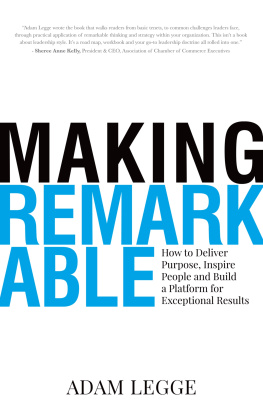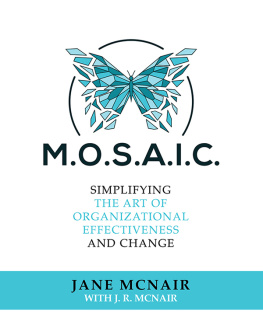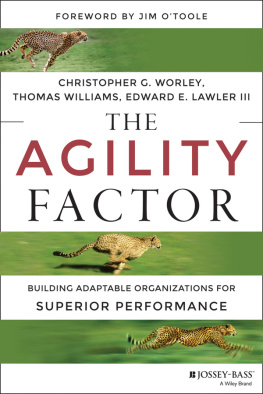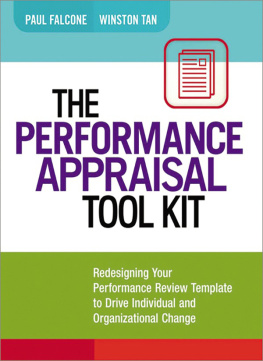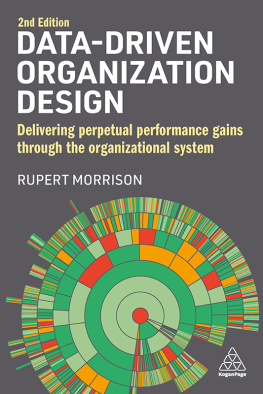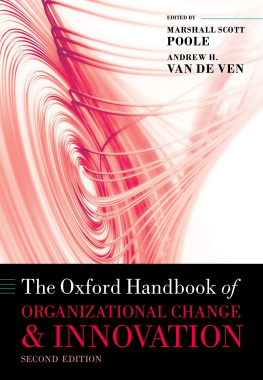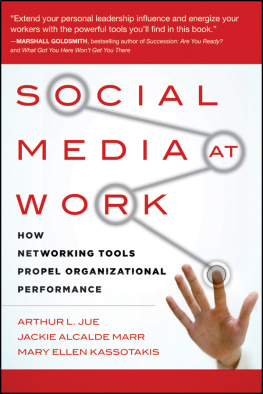Notes
Introduction
Personal interview.
Ovum.
John Tiefel, Chaos By Design: An Interview with the CEO of Zain, Voices on Transformation 3, McKinsey & Company, 2009.
Based on the application of the McKinsey corporate performance analy- sis tool developed by Richard Foster and Sarah Caplan and used extensively in the research for their book Creative Destruction: Why Companies that Are Built to Last Underperform the MarketAnd How to Successfully Transform Them (New York: Doubleday/Currency, 2001).
Personal interview.
Frederico Oliveira, Transforming a High-Performing Company: An Interview with Roberto Setubal, McKinsey Quarterly , April 2009.
I Can't Get No Job Satisfaction, That Is: America's Unhappy Workers, Conference Board Research Report #1459-09-RR, January 2010.
U.S. Bureau of Labor Statistics, using data on nonfarm businesses.
Stefan Stern, Share the Power, in Managing Employees through the Recovery, Financial Times, March 22, 2010, Special Report.
Franois Bouvard, Thomas Dohrmann, and Nick Lovegrove, The Case for Government Reform Now, McKinsey Quarterly , June 2009.
Based on analysis in Stuart Cranier and Des Dearlove, Excellence Revisited, Business Strategy Review , March 2002, updated to 2006.
Chapter 1 The Big Idea
Dean Foust, Gone Flat, BusinessWeek , December 20, 2004.
Adrienne Fox, Refreshing a Beverage Company's Culture, HR Magazine , November 1, 2007.
Ibid.
Interview by Gautam Kumra and Jim Wendler, The Creative Art of Influence: Making Change Personal, Voices of Transformation 1, McKinsey & Company, 2005.
What Successful Transformations Share, McKinsey Quarterly survey, January 2010.
Larry Bossidy, Execution: The Discipline of Getting Things Done (New York: Crown Business, 2002).
Personal interview.
William C. Taylor, Practically Radical (New York: William Morrow, 2011).
Mel Cowan, Pixar Co-Founder Mulls Meaning of Success, USC News Bulletin, University of Southern California, December 10, 2009.
C. W. Nevius, Pixar Tells Story Behind Toy Story , San Francisco Chronicle , August 23, 2005.
Ed Catmull, How Pixar Fosters Collective Creativity, Harvard Business Review , September 2008.
Bernard Simon and Telis Demos, GM Listing Marks Successful Turnround, Financial Times , November 18, 2010.
Ibid.
David Brooks, The Quagmire Ahead, New York Times , June 1, 2009.
Wendy Zellner and Stephanie Anderson Forest, The Fall of Enron, BusinessWeek , December 17, 2001.
Vicky Ward, The Devil's Casino (Hoboken, NJ: John Wiley & Sons, 2010).
Ed Crooks, Sylvia Pfiefer, and Sheila McNulty, Energy: A Sea Change Needed, Financial Times , October 6, 2010.
Sarah Boseley, Mid Staffordshire NHS Trust Left Patients Humiliated and in Pain, Guardian , February 24, 2010.
Foundation Trusts are hospitals in the NHS that are regulated by the government, but have their own board and CEO. They enjoy relative freedom to define their agenda and manage budgets, and as a result are keen to maintain their Foundation Trust status.
Katherine Murphy, Director of the Patients Association, in Outrage Greets Mid Staffordshire Hospital Report, Guardian , March 17, 2009.
Independent Inquiry into Care Provided by Mid Staffordshire NHS Foundation Trust January 2005March 2009 , vol. I, Stationery Office, London, February 24, 2010.
What Successful Transformations Share, McKinsey Quarterly survey, January 2010.
Ian Davis, How to Escape the Short-Term Trap, McKinsey Quarterly, April 2005.
What Successful Transformations Share, McKinsey Quarterly survey, January 2010.
Analysis based on Michael Beer and Nitin Nohria, editors, Breaking the Code of Change (Boston: Harvard Business School Press, 2000); Kim S. Cameron and Robert E. Quinn, Diagnosing and Changing Organizational Culture: Based on the Competing Values Framework (Reading, MA: Addison-Wesley, 1999); Bruce Caldwell, Missteps, Miscues: Business Re-Engineering Failures Have Cost Corporations Billions and Spending Is Still on the Rise, InformationWeek , June 20, 1994; State of Re-Engineering Report (North America and Europe), CSC Index , 1994; Tracy Goss, Richard Tanner Pascale, and Anthony G. Athos, The Reinvention Roller Coaster: Risking the Present for a Powerful Future, Harvard Business Review , November 1, 1993; John P. Kotter and James L. Heskett, Corporate Culture and Performance (New York: Free Press, 1992).
In Stratford Sherman, How Tomorrow's Leaders Are Learning Their Stuff, Fortune , November 27, 1995.
Louis Lavelle, Eight Isn't Enough, BusinessWeek , February 28, 2005.
Chapter 2 The Science
With hindsight, we now know that their views were often influenced by their company's choice of archetypea subject we explore in Chapter 3.
In terms of geographic reach, 35 percent of respondents are in North America, 29 percent in Europe, 26 percent in China, India, and other developed economies in Asia, and the rest in other regions. Half of the panel comes from privately held companies, 39 percent from publicly held companies, and the rest from government and nonprofit organizations.
The technical requirement for journals was a top 50 impact factor or immediacy score as calculated in the 2007 Journal Citation ReportsSocial Science Data for Business Journals.
C. K. Bart and M. C. Baetz, The Relationship between Mission Statement and Firm Performance: An Exploratory Study, Journal of Management Studies 35, no. 6 (1998).
J. C. Collins and J. I. Porras, Built to Last: Successful Habits of Visionary Companies (New York: Random House, 2005).
B. Schneider, M. G. Ehrhart, D. M. Mayer, J. Saltz, and K. Niles-Jolly, Understanding Organization--Customer Links in Service Settings, Academy of Management Journal 48, no. 6 (2005): 10171032.
S. Lieberson and J. F. OConner, Leadership and Organizational Performance: A Study of Large Corporations, American Sociological Review 37, no. 2 (1972): 11730.
A. B. Thomas, Does Leadership Make a Difference to Organizational Performance? Administrative Science Quarterly 33, no. 3 (1988): 388400.
J. P. Kotter and J. L. Heskett, Corporate Culture and Performance (New York: Free Press, 1992).
G. G. Gordon and N. DiTomaso, Predicting Corporate Performance from Organizational Culture, Journal of Management Studies 29, no. 6 (1992): 783798.
S. H. Wagner, C. P. Parker, and N. D. Christiansen, Employees that Think and Act Like Owners: Effects of Ownership Beliefs and Behaviors on Organizational Effectiveness, Personnel Psychology , no. 56 (2003): 847871.
J. B. Avey, B. J. Avolio, C. D. Crossley, and F. Luthans, Psychological Ownership: Theoretical Extensions, Measurement, and Relation to Work Outcomes, Journal of Organizational Behavior 30 (2009):173191.
S. Davis and T. Albright, An Investigation of the Effect of Balanced Scorecard Implementation on Financial Performance, Management Accounting Research no. 15 (2004): 135153.
J. Gittell, Coordinating Mechanisms in Care Provider Groups: Relational Coordination as a Mediator and Input Uncertainty as a Moderator of Performance Effects, Management Science 48, no. 11 (2002): 14081426.
A. M. McGahan and M. E. Porter, How Much Does Industry Matter, Really? Strategic Management Journal 8, no. 4 (1997): 1530.
J. Stuckey, Perspectives on Strategy, McKinsey Staff Paper, 2005, available on request from McKinsey & Company.
R. Takeuchi, Intellectual Human and Social Capital as Mediators of HR System and Outcomes: Different Mediating Mechanisms, presented at the annual meeting of the Academy of Management, August 2005.
J. Krueger and E. Killham, Feeling Good Matters, Gallup Management Journal, December 8, 2005.
D. A. Harrison, D. A. Newman, and P. L. Roth, How Important Are Job Attitudes? Meta-Analytic Comparisons of Integrative Behavioral Outcomes Time Sequences, Academy of Management Journal 49, no. 2 (2006): 305325.
Next page

